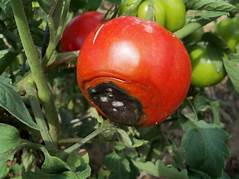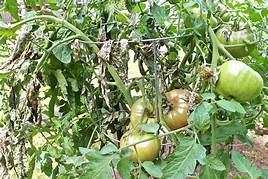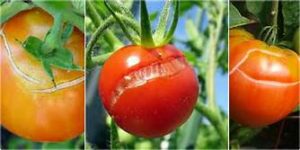By this time of the year, most people are during tomato harvest. I have been noticing blossom end rot is showing up now. This show up as a black or brown rotten area on the bottom of the tomatoes. There are several causes of this, all coming together at the same time. The main causes are when watering is inconsistent, when temperature in either too hot or cool which interferes with water uptake, soil has a lot of clay or salt content, and during fruit set the calcium in the soil cannot maintain uptake to the fruit.

Prevention is the most method of control on blossom end rot.
Blossom end rot cannot be reversed on a tomato once it’s set in, but you can take these steps to slow and halt it. Add calcium to the soil before planting and preserve affected plants by applying calcium immediately. You can use products specifically developed to treat, prevent, and slow blossom end rot in tomatoes like Tomato Rot-Stop Follow package directions for application.
Pick affected fruit to reduce stress on the plant and allow it to direct its energy to other tomatoes.
You cut out spots on harvested fruit and eat remainder. Blossom end rot does not make the rest of the tomato inedible. However, if tomatoes have been infected by fungi or mold, discard them.
Also, Work in plenty of compost and organic matter into the soil before planting, so that the plant’s root system has a better chance to grow strong and deep. Add quick-release lime when planting tomatoes so that there’s plenty of calcium in the soil and it’s absorbed quickly. Tomatoes grow best when the soil pH is about 6.5. DO NOT OVERDOSE THE SOIL WITH TOO MUCH CALCIUM.
Keep your tomatoes’ water supply even throughout the season so that calcium uptake is regular. Tomatoes need 1-3 inches of water a week. They perform best when watered deeply a couple of times a week rather than superficially every day. The best prevention in mulch plants once established to maintain moisture levels. Once blossoms emerge, apply tomato fertilizer that is high in phosphorus (the second number in a fertilizer’s three-number series), like 4-12-4 or 5-20-Too much nitrogen (the first number) or large amounts of fresh manure can prevent calcium uptake.
If their plants are severely damaged by Septoria leaf blight, fruit size will be reduced, and further development and ripening will be slowed.

Heavy rain can also lead to fruit cracking as nearly mature fruit take up more water from the plant than they can really use. Harvesting fruit before it is fully ripe can help avoid the problem if more rain is expected. Certain varieties are more prone to cracking than others like Early Girl, so do some research on the varieties you select before planting next spring. They should mention that they are crack resistant.

